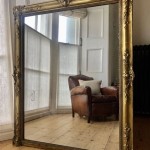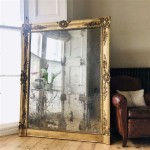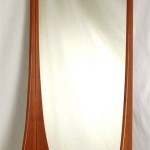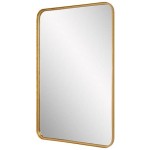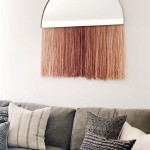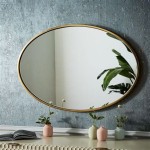What Can You Use To Hang a Heavy Mirror?
Hanging a heavy mirror requires careful consideration and the right hardware to ensure both safety and stability. Selecting appropriate hanging mechanisms depends on the mirror's weight, size, and the wall's construction material.
One of the most common methods for hanging heavy mirrors is using heavy-duty picture hooks rated for the specific weight. These hooks typically use hardened nails designed to penetrate drywall or plaster securely. It is crucial to check the weight limit on the packaging to ensure it exceeds the mirror's weight. For added security, using two or more hooks can distribute the weight and provide extra support. However, picture hooks may not be suitable for all wall types, especially brick or concrete.
D-rings and wire are another popular choice for heavier mirrors. D-rings are attached to the back of the mirror frame, and a wire is strung between them. This wire is then hung on hooks or screws driven into the wall. Using D-rings and wire allows for adjustable positioning and a more secure hang, particularly for larger mirrors. The gauge of the wire should be selected based on the mirror's weight; thicker wire supports heavier loads. For extremely heavy mirrors, using two wires, one for each D-ring, offers added stability.
J-hooks provide a robust solution for hanging heavy mirrors, especially on sturdier walls. These hooks are shaped like a "J" and are screwed directly into wall studs or masonry. The top of the "J" curves over the mirror's hanging hardware, providing a secure hold. When using J-hooks, ensuring they are anchored into a solid structural element within the wall is paramount. Failure to do this can lead to the mirror falling, causing damage and potential injury.
French cleats offer an exceptionally strong and stable hanging method for heavy mirrors and other wall-mounted items. A French cleat system consists of two interlocking pieces of wood, one attached to the wall and the other to the back of the mirror. The angled design creates a tight grip and distributes the weight evenly. This method is particularly well-suited for very large or unusually shaped mirrors where other hanging methods may prove insufficient.
Mirror mounting clips are specifically designed for securing mirrors to walls. These clips typically grip the edges of the mirror and are screwed into the wall. They offer a clean, minimalist look and are suitable for frameless mirrors. However, it's important to check the weight capacity of the clips and ensure they are appropriately sized for the mirror's thickness and weight. Using multiple clips can provide added stability and security.
Toggle bolts are an excellent choice for hanging heavy mirrors on hollow walls where finding studs isn't feasible. These bolts use spring-loaded wings that expand behind the wall surface, providing a secure anchor. Once inserted through a drilled hole, the wings expand, distributing the weight evenly across a larger area. It's important to choose toggle bolts with a weight rating appropriate for the mirror.
Anchor bolts, also known as expansion bolts, offer a secure solution for hanging heavy objects on concrete or brick walls. These bolts expand as they are tightened, creating a strong grip within the wall material. Choosing the correct size and type of anchor bolt is crucial for ensuring a secure hold. It's advisable to consult the manufacturer's instructions regarding drill bit size and installation procedures.
Adhesive solutions, like mirror mastic, can be used in conjunction with other hanging methods or in certain situations where traditional hardware is not feasible. Mirror mastic is a specialized adhesive designed to bond mirrors to walls. However, it’s important to note that mastic alone is generally not recommended for extremely heavy mirrors. It is best used as a supplementary adhesive for added security or for lighter mirrors on smooth, non-porous surfaces. It's also important to follow the manufacturer's instructions carefully for proper application and curing time.
Prior to hanging any heavy mirror, careful planning and preparation are essential. Accurately measuring and marking the desired location on the wall is critical for proper placement. Using a level ensures the mirror hangs straight. Furthermore, understanding the wall construction and choosing the appropriate hanging hardware for the specific wall type and the weight of the mirror is paramount for safety and stability. If there are any doubts about the proper installation procedure, consulting a professional handyman is always recommended.
Regardless of the hanging method chosen, it is always advisable to test the installation's strength before hanging the mirror fully. Gently applying pressure to the mirror once hung can help identify any weaknesses or instability. If any movement or looseness is detected, further reinforcement or a different hanging method should be considered.
How To Hang A Heavy Mirror On Drywall Quora

How To Hang A Heavy Mirror C R F T

How To Hang A Heavy Mirror Or Picture True Value

How To Hang A Large Or Heavy Mirror

How To Hang A Heavy Mirror With French Cleat

How To Hang A Very Heavy Picture Or Mirror The Best

How To Hang A Heavy Mirror

Picture Wire Strung Between Two D Rings Attached To The Back Of A Frame Hanging Mirror Heavy

How To Hang A Heavy Mirror The Home Depot

How To Hang A Heavy Mirror With Pictures Wikihow


